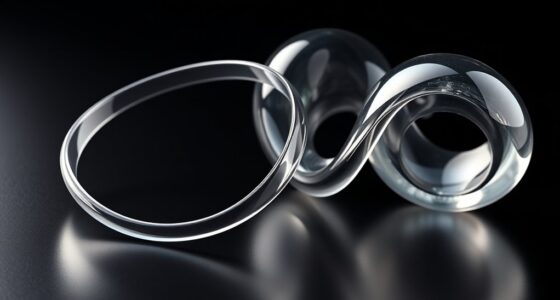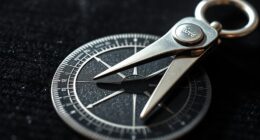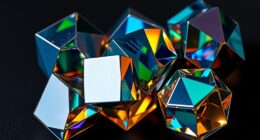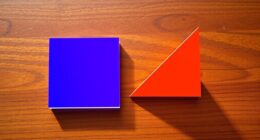Spherical geometry studies shapes and distances on Earth’s curved surface, where great circles are the largest possible circles dividing the sphere into two equal parts. They serve as the shortest routes between points, making them essential in navigation, satellite travel, and astronomy. Unlike straight lines in flat geometry, great circles appear curved on maps but maintain unique properties like intersecting at specific angles. Exploring this further reveals fascinating insights into how our world and universe are connected.
Key Takeaways
- Great circles are the largest circles on a sphere, dividing it into two equal halves, and represent shortest paths between points.
- Spherical geometry studies shapes and angles on the sphere’s surface, where triangle angles sum to more than 180°.
- Unlike Euclidean lines, great circles intersect at specific angles and can appear curved on maps due to projection distortions.
- They are essential in navigation, helping to determine shortest routes and improve accuracy in global positioning systems.
- Spherical geometry explains how signals and satellites travel around Earth, optimizing communication and space exploration.
Understanding the Basics of Spherical Geometry
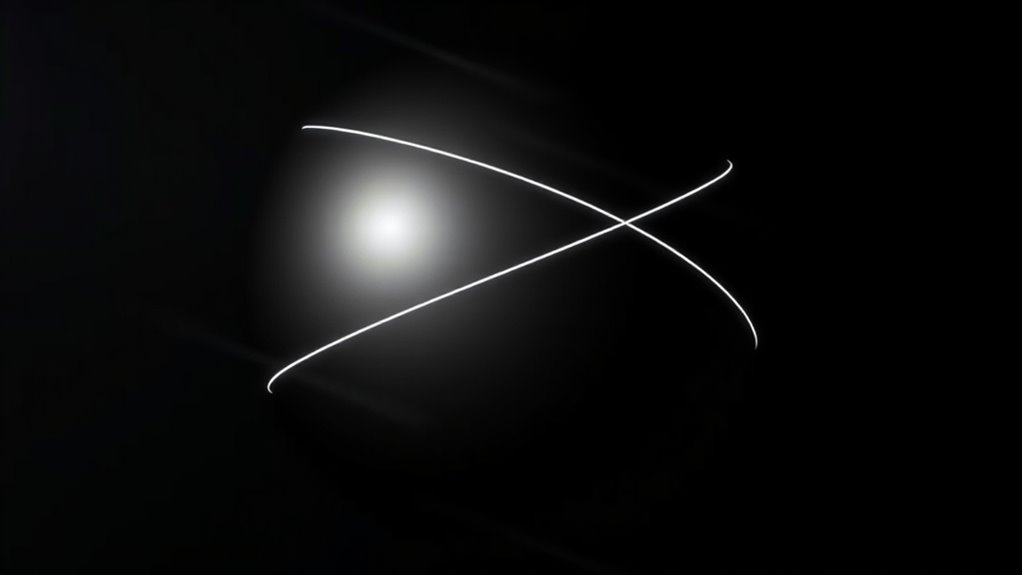
Spherical geometry differs from traditional Euclidean geometry because it studies shapes and figures on the surface of a sphere rather than in flat space. You’ll find that spherical triangles are fundamental in this geometry, formed by three great circle arcs intersecting at points. Unlike flat triangles, their angles add up to more than 180 degrees, which is a key difference. When measuring the distance between two points on a sphere, you use geodesic distances, which follow the shortest path along the surface—these are segments of great circles. Understanding these basics helps you grasp how curved surfaces influence shapes and measurements. Additionally, the concept of headphones can be useful in exploring spherical sound fields and immersive audio experiences. This foundation is essential for exploring more advanced concepts, such as how spherical triangles behave and how they relate to navigation, astronomy, and other fields.
Defining Great Circles and Their Properties

Great circles are fundamental constructs on a sphere, serving as the largest possible circles that can be drawn on its surface. They divide the sphere into two equal halves and are essential in spherical geometry. You’ll find that great circle properties include the shortest path between two points on a sphere and their role in defining spherical triangles. These triangles follow specific rules, such as the sum of angles exceeding 180°, unlike Euclidean triangles. Understanding the importance of great circles**** helps clarify their role in navigation and geographic coordinate systems.
Comparing Great Circles With Euclidean Lines
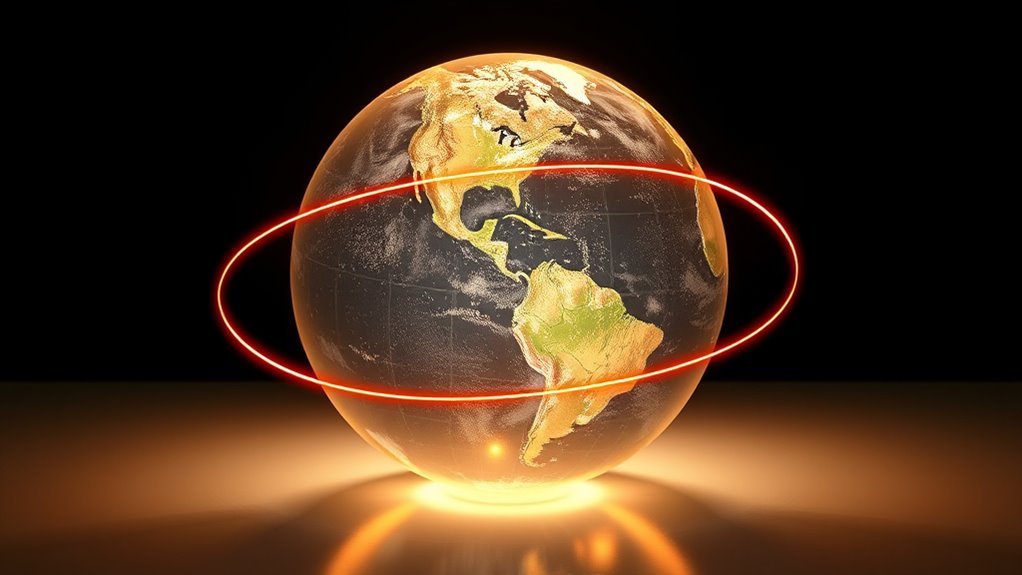
Have you ever wondered how the shortest path on a sphere differs from that on a flat surface? On a sphere, great circles represent these shortest paths, but they appear differently than Euclidean lines. Unlike straight lines in flat geometry, great circles can seem to curve and exhibit circle distortion when projected onto maps. This distortion becomes obvious because great circles intersect at angles, demonstrating line convergence on the sphere’s surface. In contrast, Euclidean lines are perfectly straight and never converge, maintaining consistent angles. While both serve as shortest routes in their respective geometries, the way they behave visually and conceptually highlights the fundamental differences between spherical and flat spaces. This comparison emphasizes how the geometry of a sphere influences the properties of these lines. Understanding their properties offers insight into how different geometries shape our perception of space.
Practical Applications of Great Circles in Navigation and Astronomy
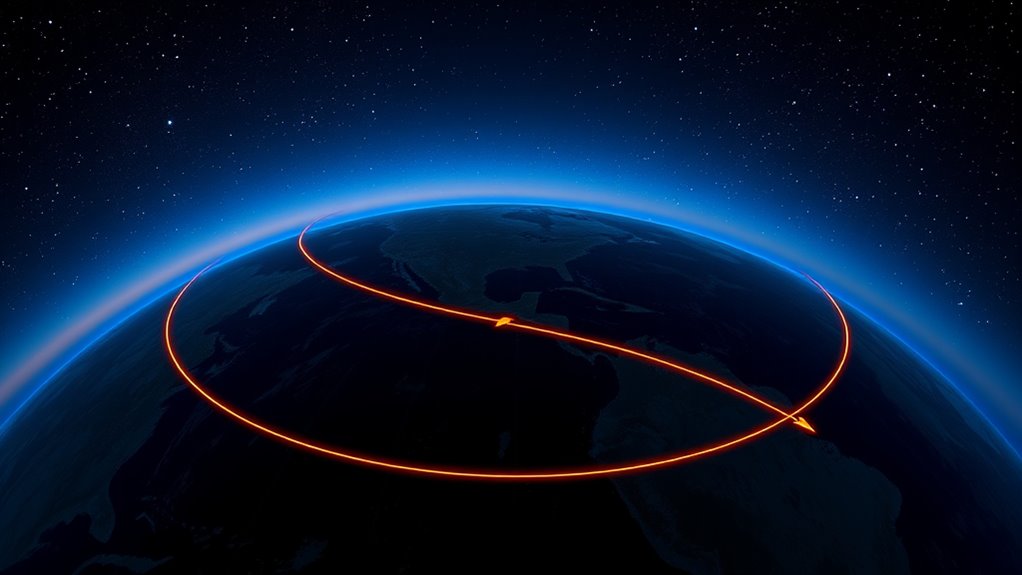
Great circles are essential for optimizing navigation routes, helping you chart the shortest path between two points on Earth. In astronomy, they assist in precise positioning of celestial objects, improving observational accuracy. Understanding these applications shows how spherical geometry directly impacts practical navigation and space exploration.
Navigational Route Optimization
Ever wondered how navigation systems determine the shortest and most efficient route between two distant points on Earth? It’s all about leveraging geodesic paths, which are the shortest routes on a sphere’s surface. These paths follow great circles, making sphere triangulation essential for accurate calculations. By analyzing the angles and positions of three points, navigation algorithms optimize routes quickly and precisely. This process reduces travel time and fuel consumption, especially for long-distance flights or maritime journeys. Modern systems use satellite data and complex algorithms to automatically identify these ideal routes, ensuring efficiency. Understanding how great circles serve as natural geodesic paths helps you appreciate their indispensable role in real-world navigation, making travel safer, faster, and more economical.
- Calculation of shortest routes
- Use of sphere triangulation
- Real-time route adjustments
- Improved navigation accuracy
Astronomical Positioning Techniques
Did you know that astronomers rely on great circles to precisely determine celestial positions? By using the concept of the celestial sphere, they track objects along great circles for accurate measurements. These circles help define satellite trajectories, allowing scientists to calculate the exact paths satellites follow across the sky. When observing stars or planets, astronomers measure their positions relative to known great circles, which serve as reference lines on the celestial sphere. This technique improves navigation accuracy for space missions and enhances our understanding of celestial motions. Great circles simplify complex calculations by providing the shortest distance between points on a sphere. Ultimately, these astronomical positioning techniques are essential for mapping the universe, guiding satellites, and advancing space exploration. Understanding spherical geometry is fundamental to these precise methods.
The Role of Spherical Geometry in Global Communication
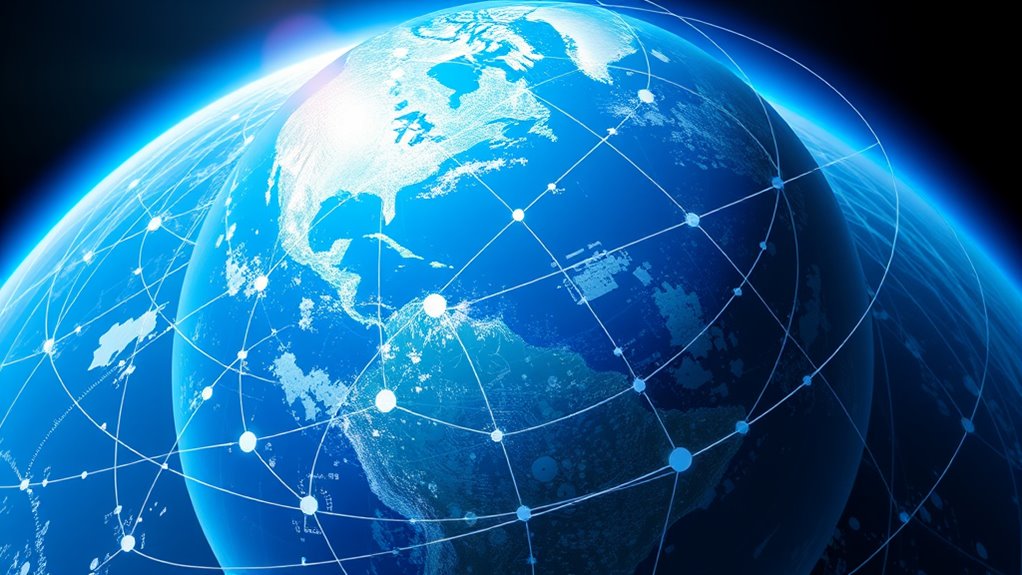
Spherical geometry plays a crucial role in enabling reliable global communication by shaping how signals travel around the Earth. It helps optimize satellite communication and ensures seamless connectivity for the global internet. Understanding the Earth’s curved surface allows engineers to design satellite orbits that maximize coverage and minimize signal loss. By applying spherical principles, communication systems can account for the planet’s curvature, improving signal strength and clarity. This knowledge also guides the placement of ground stations and satellites to create an efficient network. As a result, you experience faster internet speeds, clearer calls, and uninterrupted broadcasts worldwide. Spherical geometry is fundamental in overcoming the challenges posed by Earth’s shape, making global communication more effective and accessible for everyone.
Exploring the Surprising Results of Curved Surface Geometry

Curved surface geometry reveals results that often defy intuition, transforming how you understand shapes and distances on a sphere. For example, spherical polygons, unlike their flat counterparts, have angles that sum to more than 180 degrees, leading to surprising properties. When working with curved surface metrics, you’ll notice that the shortest paths—great circles—don’t behave like straight lines on a plane. Distances between points are measured along these curves, changing your perspective on shortest routes. These results challenge your assumptions about geometry, showing that on a curved surface, shapes and angles behave differently. By exploring these properties, you gain a deeper appreciation for curved surface metrics and the intriguing, often counterintuitive, nature of spherical geometry. Understanding these differences helps clarify why spherical geometry is essential in fields like navigation and astronomy.
Frequently Asked Questions
How Do Great Circles Relate to the Earth’s Rotation?
You might wonder how great circles relate to Earth’s rotation. As Earth turns, its rotation affects how we see celestial objects, which is vital for celestial navigation. Great circles, like the equator, represent the shortest path between two points on Earth. They help navigators determine directions accurately, especially during Earth’s rotation, making navigation easier and more precise. So, understanding great circles enhances your grasp of Earth’s rotation and navigation techniques.
Can Great Circles Be Used to Determine Shortest Paths in Other Curved Spaces?
You can use great circles to determine the shortest paths in other curved spaces by applying geodesic principles. These principles help you navigate curved space efficiently, as geodesics represent the shortest routes between points. In curved space navigation, understanding how geodesics behave allows you to find *ideal* paths, just like with great circles on a sphere. This approach extends beyond Earth, aiding in navigation across various curved geometries.
What Are the Limitations of Spherical Geometry in Real-World Modeling?
You might wonder about the limitations of spherical geometry in real-world modeling. It’s important to realize that flat models often simplify complex shapes but can lead to local inaccuracies when applied to Earth’s curved surface. These inaccuracies affect precise navigation or large-scale mapping. While spherical geometry offers better accuracy than flat models for large distances, it still can’t perfectly account for Earth’s irregularities, so you’ll need more advanced methods for precise applications.
How Does Spherical Geometry Influence Satellite Orbit Calculations?
You need to understand that spherical geometry directly impacts satellite orbit calculations by shaping your approach to modeling satellite trajectories. It influences how you apply orbital mechanics, considering Earth’s curvature and the shortest path along a great circle. This helps you accurately predict satellite positions, optimize their paths, and guarantee reliable communication and navigation systems. Without accounting for spherical geometry, your satellite trajectory computations could be markedly off, affecting mission success.
Are There Alternative Geometries That Challenge the Concept of Great Circles?
You might wonder if alternative geometries challenge the idea of great circles. Non-Euclidean shapes, like hyperbolic or elliptic geometries, offer different perspectives where straight lines or shortest paths aren’t the same as in Euclidean space. These alternative geometries show that concepts like great circles are specific to spherical shapes. So, while they work well on spheres, other geometries can complicate or redefine these fundamental ideas.
Conclusion
You now see how spherical geometry shapes our world, from navigation to astronomy. Did you know that about 71% of Earth’s surface is covered by water, making great circles essential for efficient global routes? Understanding these concepts helps you appreciate the curved surface we live on. Keep exploring, and you’ll find that even simple shapes like circles reveal profound insights about our universe and daily life.


